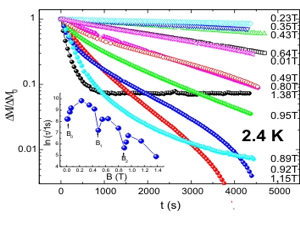Molecular Magnets
|
Molecules provide the exiting opportunity to study magnetism on the passage from atomic to macroscopic level.
One of the most interesting effects in such mesoscopic systems is the appearance of quantum tunnelling of the magnetization (QTM)
at low temperatures. In the last decade molecular chemistry has had a large impact in this field by providing new magnetic clusters with
superparamagnetic behaviour, which resembles that of conventional nanomagnetic particles, but have the advantage to form macroscopic
samples consisting of small identical high-spin clusters, which are widely separated by organic molecules. The lack of distributions in
size and shape of the magnetic clusters and the very weak intercluster interaction lead in principle to only one barrier for the spin reversal.
In the most prominent representative, Mn12-ac, 4 Mn4+ (S = 3/2) atoms in a central tetrahedron are surrounded by 8 Mn3+ (S = 2). Both are coupled antiparallel leading to a S = 10 ground state. This ground state is split into 21 sublevels describing a double-well potential according to the first term in the Hamiltonian H = DSz2 – gzμBSzBz. Whenever levels on opposite sides of the barrier have the same energy, quantum tunnelling can appear, promoted by terms which do not commute with Sz. these can be transvers components of internal fields (dipolar and/or hyperfine fields) or of external fields (e.g. due to tilting of the crystal). Investigation of the time dependence of the magnetization allows conclusion about the type of interaction of the spins with the environment and its influence on the tunnelling rate. |
Quantum tunneling
Fig.1: Time dependence of the magnetization of Mn12-ac for different fields at 2.4 K. Inset: field dependence of the relaxation time, indicating quantum tunnelling superposing thermal activation at distinct fields Bn. |
Contact: M. Reissner |


